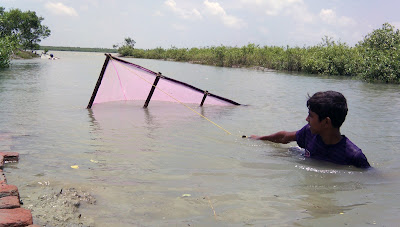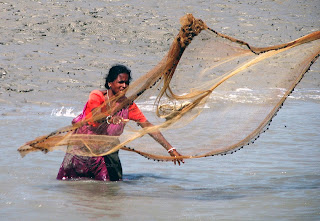The Sundarbans is not just a natural wonder of India and Bangladesh, but of the entire world. In the Bangladeshi part of the Sundarbans, there is no human settlement. However, in the Indian part, people inhabit 54 out of 105 islands, while the remaining 51 islands are covered by forests. Historically, laborers from Palamu, Chhapra, and Chhotanagpur were brought in as bonded workers to clear the mangrove forests.
1. Population and Demographics
- Total Population: 2,643,448 (Census Report, 2011)
- Geographical Area Covered: 2043 sq. km
- Total Blocks:19
- North 24 Parganas: 6 blocks
- South 24 Parganas: 13 blocks
- Total Islands:105
- Inhabited Islands: 54
- Forest-covered Islands: 51
- Gender Ratio: 945 women per 1000 men
Population Distribution by Blocks
South 24 Parganas (13 Blocks)
- Gosaba – 59,041
- Basanti – 153,528
- Canning (1) – 19,109
- Canning (2) – 136,140
- Kultali – 94,294
- Joynagar (1) – 127,919
- Joynagar (2) – 131,410
- Mathurapur (1) – 103,157
- Mathurapur (2) – 136,245
- Kakdwip – 151,343
- Namkhana – 118,446
- Patharpratima – 217,249
- Sagar – 133,365
North 24 Parganas (6 Blocks)
- Sandeshkhali (1) – 140,476
- Sandeshkhali (2) – 136,318
- Hingalganj – 156,400
- Minakha – 168,965
- Hasnabad – 177,521
- Haroa – 182,522
2. Socioeconomic Conditions
- 50% of the population is completely landless.
- 44% belong to Scheduled Castes (SC) and Scheduled Tribes (ST).
- Poverty Rate:
- SC Population: 65% live below the poverty line.
- ST Population: 38% live below the poverty line.
3. Agriculture and Economy
- The region has saline soil, making agriculture challenging.
- Major Crops: Paddy, chili, sunflower.
- Due to natural disasters, farming is frequently disrupted.
- Many residents rely on fishing, prawn farming, crab collection, and honey extraction for livelihood.
- Prawn and crab exports: These are exported to Japan, Hong Kong, and Malaysia.
4. Challenges and Risks
- Every year, many people lose their lives due to tigers, crocodiles, and natural disasters.
- Tiger Attacks: The Sundarbans is home to the Royal Bengal Tiger, and attacks on fishermen and honey collectors are common.
- Frequent Cyclones & Flooding: The region is highly vulnerable to cyclones and floods, affecting agriculture and housing.
5. Government Initiatives
- The Forest Department and State Government have launched multiple programs to support the poor.
- Various livelihood improvement and conservation programs have been introduced to protect both the people and the environment.
The Sundarbans region, despite its rich biodiversity, remains one of the most challenging places for human settlement due to its harsh natural conditions and high poverty rates.



সুন্দরবনের জনসংখ্যা ও জীবনযাত্রা
সুন্দরবন শুধু বাংলাদেশ ও ভারতের নয়, এটি বিশ্বের এক অনন্য প্রাকৃতিক বিস্ময়। বাংলাদেশ অংশে কোনো মানব বসতি নেই, তবে ভারতীয় অংশে ১০৫টি দ্বীপের মধ্যে ৫৪টিতে মানুষ বসবাস করে, বাকি ৫১টি দ্বীপ বনাঞ্চল দ্বারা আচ্ছাদিত। অতীতে পালামৌ, ছাপড়া ও ছোটনাগপুর অঞ্চল থেকে শ্রমিকদের আনা হতো বন কেটে বসতি স্থাপনের জন্য।
১. জনসংখ্যা ও গণতাত্ত্বিক তথ্য
- মোট জনসংখ্যা: ২৬,৪৩,৪৪৮ (জনগণনা রিপোর্ট, ২০১১)
- ভৌগোলিক এলাকা: ২০৪৩ বর্গ কিমি
- মোট ব্লক সংখ্যা:১৯
- উত্তর ২৪ পরগনা: ৬টি ব্লক
- দক্ষিণ ২৪ পরগনা: ১৩টি ব্লক
- মোট দ্বীপ:১০৫
- বসতিপূর্ণ দ্বীপ: ৫৪
- বনাঞ্চল দ্বারা আচ্ছাদিত দ্বীপ: ৫১
- লিঙ্গ অনুপাত: ১০০০ পুরুষের বিপরীতে ৯৪৫ নারী
ব্লক অনুযায়ী জনসংখ্যা
দক্ষিণ ২৪ পরগনা (১৩টি ব্লক)
- গোসাবা – ৫৯,০৪১
- বাসন্তী – ১,৫৩,৫২৮
- ক্যানিং (১) – ১৯,১০৯
- ক্যানিং (২) – ১,৩৬,১৪০
- কুলতলি – ৯৪,২৯৪
- জয়নগর (১) – ১,২৭,৯১৯
- জয়নগর (২) – ১,৩১,৪১০
- মথুরাপুর (১) – ১,০৩,১৫৭
- মথুরাপুর (২) – ১,৩৬,২৪৫
- কাকদ্বীপ – ১,৫১,৩৪৩
- নামখানা – ১,১৮,৪৪৬
- পাথরপ্রতিমা – ২,১৭,২৪৯
- সাগর – ১,৩৩,৩৬৫
উত্তর ২৪ পরগনা (৬টি ব্লক)
- সন্দেশখালি (১) – ১,৪০,৪৭৬
- সন্দেশখালি (২) – ১,৩৬,৩১৮
- হিঙ্গলগঞ্জ – ১,৫৬,৪০০
- মিনাখা – ১,৬৮,৯৬৫
- হাসনাবাদ – ১,৭৭,৫২১
- হাড়োয়া – ১,৮২,৫২২
২. সামাজিক ও অর্থনৈতিক অবস্থা
- ৫০% মানুষ সম্পূর্ণ ভূমিহীন।
- ৪৪% মানুষ তফসিলি জাতি (SC) ও তফসিলি উপজাতির (ST) অন্তর্ভুক্ত।
- দারিদ্র্যের হার:
- তফসিলি জাতি (SC): ৬৫% দারিদ্র্যসীমার নিচে বসবাস করে।
- তফসিলি উপজাতি (ST): ৩৮% দারিদ্র্যসীমার নিচে বসবাস করে।
৩. কৃষি ও অর্থনীতি
- লবণাক্ত মাটি হওয়ায় চাষাবাদ কঠিন।
- প্রধান ফসল: ধান, মরিচ, সূর্যমুখী।
- প্রাকৃতিক দুর্যোগের কারণে কৃষিকাজ প্রায়ই ব্যাহত হয়।
- অনেক মানুষ মাছ, চিংড়ি, কাঁকড়া ও মধু সংগ্রহ করে জীবিকা নির্বাহ করে।
- চিংড়ি ও কাঁকড়া রপ্তানি: জাপান, হংকং, মালয়েশিয়ায় রপ্তানি করা হয়।
৪. চ্যালেঞ্জ ও বিপদ
- প্রতি বছর বাঘ, কুমির ও প্রাকৃতিক দুর্যোগের কারণে অনেক মানুষ প্রাণ হারায়।
- বাঘের আক্রমণ: সুন্দরবনে রয়েল বেঙ্গল টাইগার রয়েছে, যা মধু সংগ্রাহক ও মৎস্যজীবীদের আক্রমণ করে।
- ঘূর্ণিঝড় ও বন্যা: এই অঞ্চল প্রতি বছর প্রাকৃতিক দুর্যোগের মুখোমুখি হয়, যা কৃষি ও বাসস্থানের ক্ষতি করে।
৫. সরকারি উদ্যোগ
- বন দপ্তর ও রাজ্য সরকার সুন্দরবনের দরিদ্র জনগোষ্ঠীর জন্য বিভিন্ন উন্নয়ন ও সংরক্ষণমূলক কর্মসূচি চালু করেছে।
- জীবিকা উন্নয়ন ও পরিবেশ সংরক্ষণের জন্য বেশ কয়েকটি প্রকল্প গ্রহণ করা হয়েছে।
সুন্দরবনের জনজীবন প্রকৃতির সঙ্গে এক কঠিন লড়াই। দুর্যোগ, বন্যপ্রাণী ও দারিদ্র্যের মাঝে টিকে থাকার লড়াই সত্ত্বেও এখানকার মানুষ সংগ্রাম চালিয়ে যাচ্ছে।